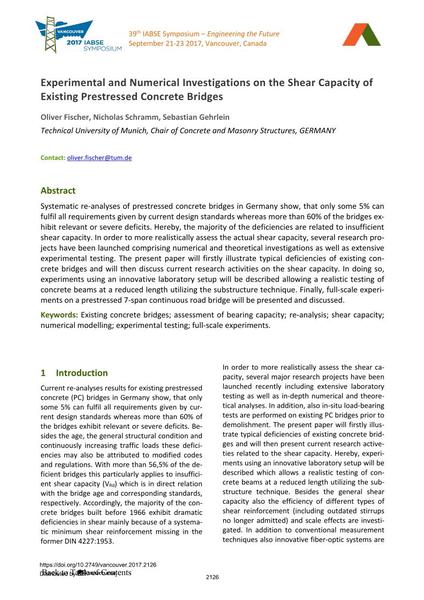Experimental and Numerical Investigations on the Shear Capacity of Existing Prestressed Concrete Bridges

|
|
|||||||||||
Bibliographic Details
| Author(s): |
Oliver Fischer
(Technical University of Munich, Chair of Concrete and Masonry Structures, GERMANY)
Nicholas Schramm (Technical University of Munich, Chair of Concrete and Masonry Structures, GERMANY) Sebastian Gehrlein (Technical University of Munich, Chair of Concrete and Masonry Structures, GERMANY) |
||||
|---|---|---|---|---|---|
| Medium: | conference paper | ||||
| Language(s): | English | ||||
| Conference: | IABSE Symposium: Engineering the Future, Vancouver, Canada, 21-23 September 2017 | ||||
| Published in: | IABSE Symposium Vancouver 2017 | ||||
|
|||||
| Page(s): | 2126-2132 | ||||
| Total no. of pages: | 7 | ||||
| Year: | 2017 | ||||
| DOI: | 10.2749/vancouver.2017.2126 | ||||
| Abstract: |
Systematic re-analyses of prestressed concrete bridges in Germany show, that only some 5% can fulfil all requirements given by current design standards whereas more than 60% of the bridges ex- hibit relevant or severe deficits. Hereby, the majority of the deficiencies are related to insufficient shear capacity. In order to more realistically assess the actual shear capacity, several research pro- jects have been launched comprising numerical and theoretical investigations as well as extensive experimental testing. The present paper will firstly illustrate typical deficiencies of existing con- crete bridges and will then discuss current research activities on the shear capacity. In doing so, experiments using an innovative laboratory setup will be described allowing a realistic testing of concrete beams at a reduced length utilizing the substructure technique. Finally, full-scale experi- ments on a prestressed 7-span continuous road bridge will be presented and discussed. |
||||
| Keywords: |
shear capacity experimental testing numerical modeling Existing concrete bridges assessment of bearing capacity re-analysis full-scale experiments
|
||||
